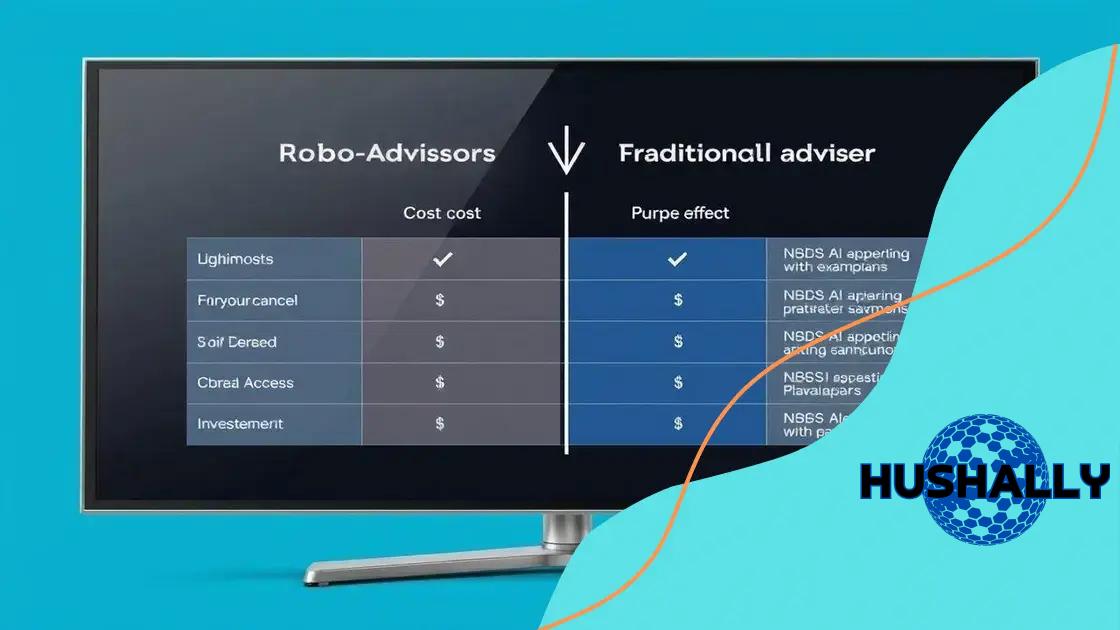Robo-advisors growing in popularity: the future of investing

Robo-advisors have gained popularity in personal finance by offering low-cost, automated investment management tailored to individual goals, making investing accessible and efficient for a broader audience.
Robo-advisors growing in popularity reflect a significant shift in how we approach investing. Have you ever wondered how these automated platforms can simplify your financial journey? Let’s explore their potential impact.
Understanding robo-advisors: what they are
Understanding robo-advisors is essential for anyone looking to simplify their investment journey. These innovative platforms use algorithms to manage your investments based on your financial goals and risk tolerance.
The benefits of using robo-advisors are plentiful. They provide a cost-effective way to get professional investment management, making finance accessible to more people than ever before.
How Robo-Advisors Work
Robo-advisors operate by automating the investment process. They typically require you to complete a questionnaire that assesses your financial goals and risk appetite. Based on this information, the software creates a tailored portfolio for you.
Once your initial investment is made, robo-advisors continuously monitor and reallocate your assets to ensure they align with your goals. This automated rebalancing helps maintain your desired level of risk.
Key Features of Robo-Advisors
- Low fees compared to traditional advisors
- Automated investment management
- Diversified portfolios to reduce risk
- Easy access to account information anytime
Many robo-advisors also offer tax loss harvesting, a strategy that minimizes taxes owed on your investment gains. This is just one example of how these tools can enhance your investing experience.
While robo-advisors provide ease of use and efficiency, it’s important to research and choose one that meets your specific needs. Look for platforms that align with your investment philosophy and offer the services important to you.
In conclusion, understanding robo-advisors involves recognizing their function and benefits in modern investing. They represent a significant shift toward accessible, automated financial management for individuals.
Key benefits of using robo-advisors
Using robo-advisors brings several advantages to both new and seasoned investors. Their automated services make investing more accessible and streamlined, catering to a variety of financial goals.
One significant benefit is the low cost associated with robo-advisors. Traditional financial advisors often charge high fees for their services, which can cut into your investment returns. In contrast, robo-advisors typically have much lower fees and offer clear pricing structures.
Efficiency and Convenience
Robo-advisors provide a level of efficiency that traditional methods can’t match. By automating tasks like portfolio management and rebalancing, these platforms save you time and effort. You can set your investment preferences and let the software handle the rest.
- 24/7 access to your accounts
- Instant portfolio adjustments
- Automatic tax loss harvesting
Another advantage is that robo-advisors often utilize sophisticated algorithms to create diversified portfolios. They analyze market trends and allocate your investments wisely, helping to minimize risk while maximizing returns.
Moreover, robo-advisors are designed with user-friendly interfaces. Most platforms are easy to navigate, allowing you to keep track of investments without feeling overwhelmed. This approach eliminates the intimidation factor often associated with investing.
Personalization and Accessibility
Many robo-advisors also offer personalized investment strategies based on your risk profile. By answering a few questions, you can have a portfolio tailored specifically to your needs. This service breaks down barriers and opens investment opportunities to individuals who may not have much experience.
In terms of accessibility, robo-advisors may require lower minimum investments, allowing more people to enter the investment landscape. This democratization of investing is essential for many, as it encourages saving and financial growth.
How robo-advisors differ from traditional advisors

Understanding how robo-advisors differ from traditional advisors is key to making informed financial decisions. While both aim to help you grow your investments, they do so in very different ways.
Traditional advisors provide personalized services, often offering face-to-face meetings and custom financial plans. They assess your financial situation in detail and may offer insights based on years of industry experience. In contrast, robo-advisors rely on algorithms and technology to create investment strategies. They automate the investment process, which makes it quick and efficient.
Cost Differences
One of the most significant differences between these two types of advisors is cost. Traditional advisors often charge hefty fees, which can include commissions and annual management fees. This can add up quickly and affect your overall returns. On the other hand, robo-advisors usually have low fees, allowing you to keep more of your money invested and working for you.
- Traditional advisors: 1-2% fee based on assets
- Robo-advisors: typically 0.25-0.75% fee
- No commissions on trades
- Flat monthly or annual fee structures
Moreover, robo-advisors offer ease of use through online platforms. You can easily create and manage your account from the comfort of your home, something traditional advisors may not provide if they prioritize in-person consultations. This online access includes portfolio tracking, which is available 24/7.
Investment Strategy
When it comes to investment strategies, traditional advisors often build personalized portfolios based on in-depth conversations. They take into account not just your financial goals but also your personality and preferences. In contrast, robo-advisors operate on a more formulaic basis, using algorithms that typically diversify your investments across various asset classes.
This algorithm-driven approach can lead to effective portfolio management but may lack the personal touch that comes with a human advisor. Additionally, robo-advisors often include automated rebalancing, where they adjust your portfolio to keep it aligned with your risk level and goals.
Important features to look for in a robo-advisor
Choosing the right robo-advisor involves understanding the essential features that can enhance your investing experience. With various platforms available, knowing what to look for can help you select one that fits your needs.
First, consider the fees associated with the robo-advisor. Lower fees can significantly impact your investment growth over time. Many platforms charge a flat percentage of assets under management, so it’s crucial to find one with competitive pricing.
User Experience
The user interface is another important feature. A clean and intuitive design can make managing your investments easier. Ensure the platform provides a mobile-friendly experience, allowing you to track your portfolio on the go.
- Clear account setup process
- Accessible customer support
- Mobile app availability
Also, look for a robo-advisor that offers automated rebalancing. This feature adjusts your portfolio automatically when your investments drift away from your target asset allocation due to market changes. It helps maintain your desired risk level without requiring constant oversight.
Diversification and Customization
Diversification is key to managing risk. A good robo-advisor should offer a variety of investment options across different asset classes. This helps to spread risk and enhance potential returns. Additionally, check if the platform allows for some customization based on your preferences.
Some robo-advisors provide personalized investment strategies, which tailor portfolios based on your risk tolerance and financial goals. This can significantly benefit investors who have specific requirements.
Finally, assess whether the robo-advisor offers additional features like tax loss harvesting. This strategy can save you money by minimizing tax obligations on your investments. Such features enhance the overall value of using a robo-advisor.
The future of robo-advisors in personal finance
The future of robo-advisors in personal finance looks bright, with technology continuing to evolve and adapt to consumer needs. As more individuals seek efficient and affordable ways to manage their investments, robo-advisors are expected to play a pivotal role in shaping the financial landscape.
One key aspect of this future is the integration of artificial intelligence. AI can enhance the functionality of robo-advisors by enabling more advanced algorithms. This advancement promises better personalization in investment strategies based on real-time market conditions and individual performance data.
Increased Accessibility
Accessibility is another area where robo-advisors will thrive. As internet usage grows globally, more people will be able to access these digital platforms. This democratization of investment services allows even those with smaller amounts to invest to benefit from professional management.
- Lower minimum investment requirements
- Expanded services for personalized financial planning
- Broader market access and financial literacy resources
Another element to consider is the potential for robo-advisors to integrate other financial services. Future platforms may combine investment management with banking, lending, and insurance products, creating a comprehensive financial ecosystem.
Regulatory Changes
Regulatory changes will also impact the future of robo-advisors. As more users rely on these platforms, regulators may introduce new guidelines to protect consumers and ensure fair practices. Adapting to these regulations while maintaining innovation will be vital for robo-advisor providers.
Moreover, as competition increases, robo-advisors will strive to differentiate themselves. Enhanced features, educational tools, and improved customer service will be critical as these platforms aim to attract and retain users amidst a growing market.
FAQ – Frequently Asked Questions about Robo-Advisors
What are robo-advisors?
Robo-advisors are automated platforms that provide financial planning services with minimal human intervention, using algorithms to manage investments.
How do robo-advisors differ from traditional financial advisors?
Robo-advisors usually offer lower fees, automated portfolio management, and a more user-friendly online experience compared to traditional advisors.
What features should I look for in a robo-advisor?
Look for low fees, ease of use, automated rebalancing, and a variety of investment options to suit your financial goals.
Are robo-advisors a good choice for beginner investors?
Yes, robo-advisors are excellent for beginners due to their low minimum investment requirements and straightforward interfaces.





